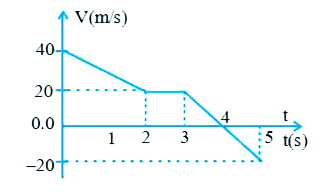If the work done by a body on application of a constant force is directly proportional to the distance travelled by the body, express this in the form of an equation in two variables and draw the graph of the same by taking the constant force as 5 units. Also read from the graph the work done when the distance travelled by the body is (i) 2 units (ii) 0 unit.
To solve the problem step by step, we will express the relationship between work done and distance traveled in the form of an equation, draw the graph, and then read the work done for specific distances.
Step 1: Define the Variables
Let:
- x = distance traveled by the body (in units)
- y = work done by the body (in units)
Step 2: Establish the Relationship
According to the problem, the work done is directly proportional to the distance traveled. This can be expressed mathematically as:
y∝x
This means that:
y=kx
where k is the constant of proportionality.
Step 3: Substitute the Constant Force
We are given that the constant force is 5 units. Therefore, we can substitute k=5 into our equation:
y=5x
Step 4: Create a Table of Values
To draw the graph, we will create a table of values for x and y:
| x | y=5x |
|---------|---------------|
| 0 | 0 |
| 1 | 5 |
| 2 | 10 |
| 3 | 15 |
| 4 | 20 |
| 5 | 25 |
Step 5: Draw the Graph
- On the x-axis, plot the values of x (0 to 5).
- On the y-axis, plot the corresponding values of y (0 to 25).
- Plot the points (0,0), (1,5), (2,10), (3,15), (4,20), and (5,25).
- Connect the points to form a straight line, which represents the equation y=5x.
Step 6: Read the Work Done for Specific Distances
1. When the distance traveled is 2 units:
- From the table, when x=2, y=10.
- Therefore, the work done is 10 units.
2. When the distance traveled is 0 units:
- From the table, when x=0, y=0.
- Therefore, the work done is 0 units.
Summary of Results
- The equation representing the relationship is y=5x.
- The graph is a straight line passing through the origin.
- The work done when the distance traveled is 2 units is 10 units.
- The work done when the distance traveled is 0 units is 0 units.
Let:
- x = distance traveled by the body (in units)
- y = work done by the body (in units)
According to the problem, the work done is directly proportional to the distance traveled. This can be expressed mathematically as:
y∝x
This means that:
y=kx
where k is the constant of proportionality.
We are given that the constant force is 5 units. Therefore, we can substitute k=5 into our equation:
y=5x
To draw the graph, we will create a table of values for x and y:
|---------|---------------|
| 0 | 0 |
| 1 | 5 |
| 2 | 10 |
| 3 | 15 |
| 4 | 20 |
| 5 | 25 |
- On the x-axis, plot the values of x (0 to 5).
- On the y-axis, plot the corresponding values of y (0 to 25).
- Plot the points (0,0), (1,5), (2,10), (3,15), (4,20), and (5,25).
- Connect the points to form a straight line, which represents the equation y=5x.
1. When the distance traveled is 2 units:
- From the table, when x=2, y=10.
- Therefore, the work done is 10 units.
- From the table, when x=0, y=0.
- Therefore, the work done is 0 units.
- The equation representing the relationship is y=5x.
- The graph is a straight line passing through the origin.
- The work done when the distance traveled is 2 units is 10 units.
- The work done when the distance traveled is 0 units is 0 units.
Topper's Solved these Questions
- LINEAR EQUATIONS IN TWO VARIABLESBOOK - NCERT ENGLISHCHAPTER - LINEAR EQUATIONS IN TWO VARIABLESEXERCISE - EXERCISE 4.2
4 Videos
- LINEAR EQUATIONS IN TWO VARIABLESBOOK - NCERT ENGLISHCHAPTER - LINEAR EQUATIONS IN TWO VARIABLESEXERCISE - SOLVED EXAMPLES
9 Videos
- INTRODUCTION TO EUCLIDS GEOMETRYBOOK - NCERT ENGLISHCHAPTER - INTRODUCTION TO EUCLIDS GEOMETRYEXERCISE - Exercise 5.1
7 Videos
- LINES AND ANGLESBOOK - NCERT ENGLISHCHAPTER - LINES AND ANGLESEXERCISE - Exercise 6.1
6 Videos
Similar Questions
Knowledge Check
In the given v-t graph the distance travelled by the body in 5 seconds will be
 A100 mB80 mC40 mD20 m
A100 mB80 mC40 mD20 m
The work done by kinetic friction on a body :
View SolutionThe force acting on a body is inversely proportional to the distance (x) covered. The work done is proportional to
View SolutionA body is acted upon by a force which is inversely proportional to the distance covered. The work done will be proportional to
View SolutionThe distance travelled by a freely falling body is proportional to
View SolutionYou know that the force applied on a body is directly proportional to the acceleration produced in the body. Write an equation to express this situation and plot the graph of the equation.
View SolutionThe force exerted to pull a cart is directly proportional to the acceleration produced in the body. Express the statement as a linear equation of two variables and draw the graph of the same by taking the constant mass equal to 6 kg. Read from the graph, the force required when the acceleration produced is
(i)5ms−2 (ii)6ms−2
View SolutionDraw a velocity-time graph for a body moving with an initial velocity u and uniform acceleration a. Use this graph to find the distance travelled by the body in time t.
View Solution

